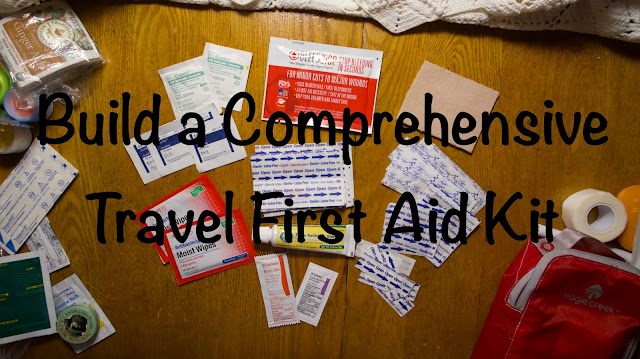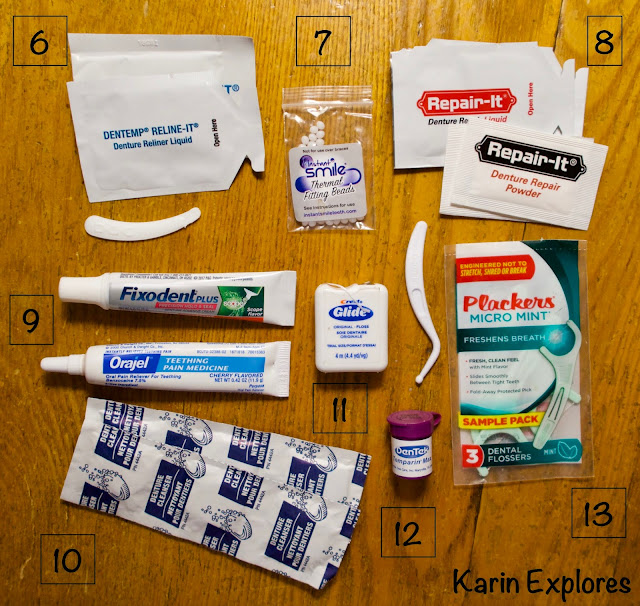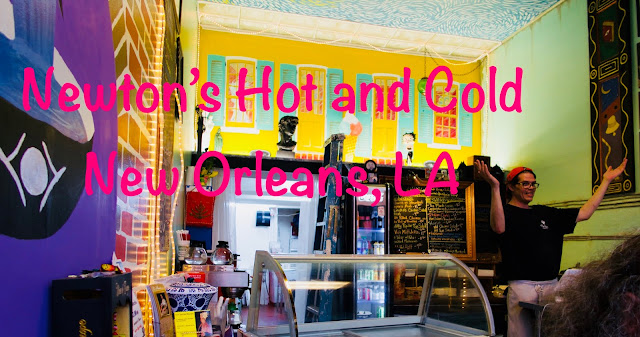Comprehensive Travel First Aid
Each of the photos represent the items which are stored in individual snack-size "zip" bags, which are in turn put in a nylon packing cube. Let's take a look at what is in my kit and why I included it:
The first baggie contains items needed to make repairs while traveling. Anything from a lost button to a broken shoe can be repaired helping to make quick fixes. (1) E6000 and Krazy Glue allow me to make repairs on the fly. (2) An extra Velcro wire strap comes in handy for more than just corralling cords. Velcro straps are amazingly versatile. (3) Super sticky Velcro again can be the answer to many unexpected problems while traveling. (4) A variety of safety pins, straight pins, and some simple buttons are solutions to a staggering number of issues that come up while traveling. *Notice there is no thread? I use dental floss to sew on buttons or make simple repairs. For dark clothes you can color the floss with a permanent marker.
The next baggie contains all things oral health. Because I wear a denture partial I have included things to repair it should it get broken. (6) An acrylic repair kit for the acrylic portion of the plate, (7) plastic beads that can be molded using boiling water to replace any missing or broken teeth off the plate, and (8) a relining kit allows me to reline my plate should I need to make a repair. All three of these are temporary repairs, but will allow me to continue to smile until I can get to a dentist. (9) Fixodent to help keep my temporarily repaired plate in place (normally I do not need to use this product as my plate fits perfect) and Orajel can be invaluable to help reduce the blinding pain of a toothache. I purchased both of these at my local dollar store, so they are smaller tubes than normally found in other stores which is perfect for an urgent situation. (10) Extra denture cleaning tablets included so a denture can be cleaned before making any emergency repairs. (11) Dental floss for both flossing and for making emergency sewing repairs. (12) Temporary filling material in the event of a lost filling. (13) Flossing picks to reach between spaces in teeth.
I don't know about you, but I need my glasses to see clearly. Over the years my prescription has increased and I now wear bifocals. I can't imagine traveling in London to all the amazing museums there and only seeing a fuzzy view of the art. (14) Disposable wet cleaning wipes are convenient for on the go cleaning of lenses. (15) Screwdrivers which fit the tiny screws in eyeglasses are important as is a (16) soft cloth to hold the glasses with during repairs. Since you can't see really well when you are repairing your own glasses, (17) a small magnifying glass will come in handy. (18) A variety of sizes of eyeglass screws and replacement nose pads are a must. (19) Eye drops to help lubricate tired or dry eyes will come in handy. (20) An eye pad will help to cover any eye injuries while seeking medical attention.
For minor strains or sprains from all the walking you will be doing, include an (23) ice bag (this one I saved from a prior surgery) or just use a (22) zip bag to ice your injuries. If you need to rotate a hot compress with the cold, a pack of air-activated (21) Hot Hands fit the bill. A bonus is Hot Hands come in handy in very cold climates to help prevent frostbite.
Dealing with minor cuts, burns, scrapes, etc. is easy when you have a well-stocked first aid kit. (24) Pads to clean and disinfect the wound are mandatory in any kit. I have two kinds in mine as I know alcohol prep pads burn. However, should I run out of the less painful wipes, I have a couple of these prep pads at my disposal. Before cleaning any wounds, the caregiver needs to clean and disinfect their hands as well. I include (25) antibacterial moist wipes to clean my hands with first. (26) Burn cream and antibiotic ointments help to prevent infections and (27) a wide variety of bandages, including butterfly closures, allow me to keep wounds clean and covered. Finally, to prevent blisters from shoes I will occasionally put a bandage on a hot spot, however (29) Moleskin is the best way to deal with those hotspots from the get go.
Included in my kit is a pack of (28) BleedStop which almost instantly stops bleeding. If you have a loved on on blood thinners, you should not be without this little packet of magic.
I keep a couple of (30) tongue depressors to use for splints as well as for looking at the throat. They can be snapped to the necessary length and (31) medical tape will hold the depressor in place. (32) a finger splint is a surprisingly helpful tool to have as falls will also cause injuries to fingers. (32) Light (or teen) tampons make a great way to help stop a nosebleed. To further deal with wounds with heavy bleeding, (33) a sanitary pad is both absorbent and allows you to apply pressure. I don't know many women who don't have a pad or tampon "just in case" and keeping a couple in your first aid kit helps them do double-duty.
Hopefully, I you have used the Anti-Illness Protocol, you will dodge catching a cold while traveling, but just in case you do catch a cold or sinus issue, these will help keep you going. (34) a disposable thermometer will confirm if you have a fever or not. (35) Nasal Spray will allow you to breathe by opening up the sinus. I keep some (36) Pearls (available from your doctor by prescription in the US) for decongestion.** (37) Breathe Right Strips will help keep your nasal passages open and snoring to a minimum so you get recuperative rest. As an asthmatic I also keep an inhaler in my kit, but I have another in my purse as well.
I love to take cruises, but not everyone has their sea legs right away. To deal with motion sickness I included (38) Ginger Tea bags in my kit. Ginger is a natural way to settle your stomach. Ginger chews work as well, but tea is a good way to keep up on your fluids. (39) Kaopectate** helps to reduce and stop diarrhea (the dreaded Montezuma's Revenge) which is not uncommon when traveling. (40) Dramamine is a medicine which will stop the symptoms of motion sickness. (41) Tums will help settle down your stomach and also reduce burning from stomach acid.
I have several medicines, both over the counter and prescribed, I take with me when traveling. (35) I take my prescription pain medication (Neurontin), (46) Ibuprofen, (47) Benadryl (I take it for sleep and for allergies), (48) Lasix for water retention (getting old is a bitch, lol). I include a (49) Diflucan in my kit for feminine yeast infection.
**I put all my pills in Go Tubbs which are super handy. You can remove the lid with just one hand, they have a space to label them, and the different colors of container lids helps you find your needs quickly.
Finally, I add a few items that are both convenient and necessary. (50) Laundry Soap Sheets allow you to hand wash in the sink. (51) A small penlight flashlight will allow you to see more clearly. (52) Cotton tipped applicators to apply creams and gels. (53) A small pocket knife with scissors (I have to put this in my checked baggage when flying). (54) Tweezers!
All of these items fit neatly into an Eagle Creek Half Cube or you can keep your medications separate and fit it all in an Eagle Creek Quarter Cube. I also have a couple pair of rubber gloves in the kit as well.
Remember to never check your medications when traveling as you run the risk of never seeing them again. Keeping a good first aid kit with you can help save a vacation.
Is there anything you think is missing from my kit? Please share in the comments.
Happy Travels!














Comments
Post a Comment